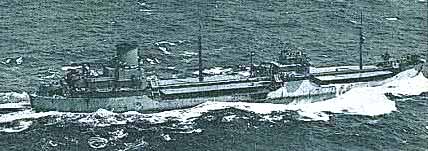U.S. Merchant Marine Ships Rescue Army Air Corps and Navy Air Crews
MV Esso Little Rock Rescues Navy Crewmen
During World War II, Merchant Marine tankers carried fuel from far-flung oil fields in the Caribbean and Persian Gulf to the battle zones and for domestic use. They replenished Navy oilers stationed in the South Pacific, and directly refueled oil-hungry battleships and aircraft carriers. They also brought aviation fuel for fighters and bombers.
On September 24, 1943, the tanker Esso Little Rock, left Espiritu Santo, New Hebrides, on a routine run from the South Pacific to the Caribbean to load fuel. Her Master was Captain Roland Whittom, of Elizabeth, New Jersey, who had been with Esso since 1919. Chief Engineer Ogden E. Power was in charge of her engine room.
The Esso Little Rock, built in 1940 by Sun Shipbuilding and Dry Dock at Chester Pennsylvania for Standard Oil, was considered a large tanker. At 17,950 deadwight ton capacity, she could carry nearly 7 million gallons of fuel.
MS Esso Little Rock underway [US Navy photograph]The routine of the voyage was broken at 1 PM on October 15, 1943, as a Navy PBY seaplane flew over the ship at masthead height and dropped a message in a weighted canvas pouch. The container fell on the bridge within a few feet of Second Mate Ernest Johnson, the officer on watch. The penciled message read:
"Disabled plane on water 06 deg. 03' North, 86 deg. 10' West, bearing 060 deg. true from Cocos Island at distance of 65 miles. Proceed and give assistance. Ensign John D. Robinson, Patrol Plane Commander 206-P-13."
Traveling at her top speed of 15 knots, the Esso Little Rock covered the 158 miles to the reported position that night. The area was between Nicaragua and the Galapagos Islands. Arriving at the location, the ship cast her searchlight on the low hanging clouds, hoping to see a red flare in response.
The Esso Little Rock sailed downwind mile after mile, while playing the searchlight back and forth on the clouds. Just when the crew was starting to give up hope -- about 18 miles from the original location -- they sighted a red flare almost dead ahead, but still quite a distance away. It was 1:35 AM, October 16. They steered in the direction of the flare and at 3 AM came alongside a Navy Catalina patrol bomber floating on the seas.
The Navy Catalina Patrol Bomber
During a routine patrol flight, a rubber hose on the manifold that controlled the supply of gasoline to the engine suddenly split, and pumped more than 250 gallons of aviation fuel into one of the hull compartments. The whole interior was filled with explosive fumes, and fuel was all over the electrical equipment.As soon as the rubber hose split, the pilot brought the seaplane down and the men climbed out onto the wings. The plane was in sight of Cocos Island, but they could not use the radio to call for help because of the danger of explosion.
The men flooded the plane's compartment with sea water to wash out the fuel. They took turns braving the gas fumes: each bailed for a minute or so, or as long as he could hold his breath. They flooded the cabin over and over, and bailed water constantly for 24 hours.
When the cabin was finally clear of fumes they used the radio transmitter to send a message to their base at Balboa, Panama Canal Zone, reporting their position. A Navy PBY which was searching for the missing bomber and heard the distress call, found them within 20 minutes. It circled further, found the Esso Little Rock, and dropped the message on board.
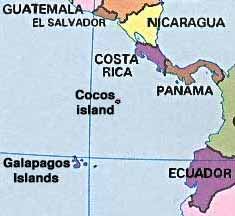 |
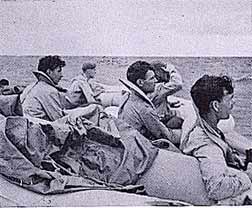 |
| Map of the region near Cocos Island | Navy fliers scan the horizon looking for their rescuers. From left to right are: Plane Captain W. K. Aldridge, AOM 3rd Class O. H. Wells, Radioman J. F. Tunney, Lieut. (j. g.) L. W. Frawley, AMM 2nd Class E. J. Coe [US Navy photograph taken by Lieut. (j.g.) F. J. Whiteside] |
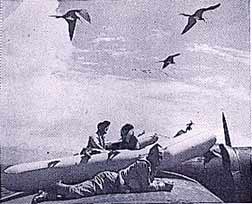 |
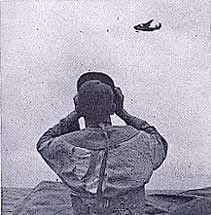 |
| Crew of Navy Catalina Patrol Bomber relaxes on top of plane while awaiting rescue. Above them are frigate birds. [US Navy photograph taken by Lieut. (j.g.) F. J. Whiteside] | AOM 3rd Class O. H. Wells looks at patrol plane [US Navy photograph taken by Lieut. (j.g.) F. J. Whiteside] |
The Rescue
The crew of the Esso Little Rock launched a lifeboat under the command of Chief Mate Ralph E. Porter. Also in the boat were:
Stigmo U. Mofelt, Junior Engineer [at right receiving Meritorious Service Medal citation]
Melvin L. Eades, Bosun
Robert R. Fagan, Able Seaman
Nick Deftereos, Able Seaman
Sylvester Kacipenski, Able Seaman
William Heapes, Navy Armed Guard SignalmanThe seas were choppy as Chief Mate Porter maneuvered the lifeboat close to the drifting plane. To get the survivors off, Porter had to bring the lifeboat under the swaying wing of the bomber, which constantly threatened to crush the lifeboat and the men at the oars. His timing had to be perfect.
Porter rescued the entire crew of eight fliers without injury to them or to his own men. One of the fliers later said, "I didn't know whether to get off the wing or not. The boat looked so damn small!"
The airplane was destroyed by gunfire from the Esso Little Rock at the request of Lieutenant W. K. Aldridge, captain of the plane.
Even after 43 hours on the wings, the Navy fliers were in good physical condition, albeit cold and hungry. Their food and water supplies had been ruined by the fuel, but heavy rain had given them plenty of drinking water.
The eight rescued men came aboard the Esso Little Rock at 4 AM. They were given hot showers and dry clothing, and soon sat down to a hot meal of ham and eggs and coffee, courtesy of Chief Steward Albert S. Howald and his staff. The ship's crew and Navy Armed Guard gave up bunks to the fliers for the duration of the voyage.
Only ten hours elapsed from the time the ship received the emergency order until they made the rescue. At Balboa, the navy officer who came aboard to take charge of the rescued men gave to Captain Whittom the following letter of commendation:
"Command Panama Sea Frontier sends his sincerest appreciation and thanks in recognition of the splendid performance of the Esso Little Rock in rescuing the Navy plane crew on October 16."
All the men were awarded the Meritorious Service Medal.
SS John Howard Payne Rescues Army Fliers
In March 1945, the SS John Howard Payne, was requested by radio to locate and assist possible survivors of an Army plane which had crashed at a given location in the Pacific Ocean seventy miles distant from the ship's position. The Master, Orion A. Larson, immediately proceeded at full speed to render assistance. On arrival in the area, during darkness, a systematic search was instituted and continued for several hours until a flare was sighted which proved to be from the plane's rubber life raft supporting two men. Weather conditions were unfavorable for rescue operations. The sea was rough and there was a heavy swell running which caused the ship to roll through an arc of 28 degrees. A lifeboat, manned by the chief mate and six others, was lowered with great difficulty and proceeded on its precarious mission. The master maneuvered his ship to afford a lee for the boat. The removal of the two men from the raft and recovery of the boat and personnel were accomplished with great difficulty and at very definite risk to the rescued men and boat's crew.The men manning the lifeboat received Meritorious Service Medals:
Leroy W. Accord, Able Seaman
George R. Bones, Jr., Ordinary Seaman
Laurens W. Hunniccutt, Chief Engineer
Kenneth W. Leonard, Boatswain
Robert Burns Logan, Second Mate
Arthur M. Matlock, Chief Mate
Kenneth George Neilsen, Able Seaman
SS Mormaclark Rescues Army Fliers
The SS Mormaclark, a C-1 cargo ship was sailing in New Guinea waters when the crew saw a U.S. Navy Catalina flying boat crash about a mile away. Captain J. E. Ihle of Flushing, NY, ordered the ship to head towards the crash area. When they reached the site, Able Seaman William Needham of Honolulu, Hawaii, spotted a flier who was severely injured, without a lifejacket or other support, and near drowning. Needham, disregarding the danger from sharks attracted by the blood of the wounded men, dove into the sea, swam 150 yards to Robert Ayers, and towed him to the ship. Meanwhile, once the ship stopped, the crew lowered a lifeboat which rescued two other badly injured men who were clinging to a mattress.Needham was awarded the Merchant Marine Distinguished Service Medal
SS Howell Lykes Rescues 6 Army Fliers
The SS Howell Lykes, commanded by Captain William Henderson, Lamarque, Texas, rescued 6 Army fliers while sailing from New Guinea to the United States. The fliers were on two rubber rafts which were being tossed about in heavy seas. The ship ran alongside the rafts and the men were helped aboard. They suffered from bruises and black eyes from their crash landing.
MV Cape Greig Rescues Army Fliers
HEADQUARTERS
19TH BOMBARDMENT GROUP
APO 246 Unit 2
c/o Postmaster
San Francisco, California12 June 1945
| SUBJECT: | Letter of Appreciation and Commendation. |
| TO: | The Officers and men of the United States Merchant Ship Cape Greig, |
| c/o Postmaster, San Francisco, Calif. |
1. It is desired to commend you, the officers and men of United States Merchant Ship Cape Greig, and to express to you the appreciation of the 19th Bombardment Group for the heroic act and meritorious service you rendered in rescuing the following named officer and men of this Group:
Lieutenant Paul T. Klenk Sergeant Andrew M. Doty Sergeant James C. Dudley Sergeant Rea Schuessler 2. To rescue these B-29 crew members who had parachuted from their distressed aircraft, you, with utter and complete disregard for your safety, turned your ammunition-laden ship into unknown waters. You further increased the danger to yourselves by using searchlights to seek and find the destitute airmen the destitute airmen on the blacked-out sea.
3. This voluntary assumption of risk on your part resulted directly in the rescue of the four above-named men and is the personification of the highest ideals and tradition of the Maritime and Naval Service. The officers and men of the 19th Group join me in saying "Thank you" and "Well done."
/s/ John A. Roberts
JOHN A. ROBERTS
Colonel, Air Corps
Commanding
Sources:
Photo of Catalina PBY courtesy www.pby.com
Map adapted from http://www.lib.utexas.edu/Libs/PCL/Map_collection/cia99/americas_pol96.jpg
Courtesy of John Strand, son of Knut Strand, Master of the Cape Greig
Ships of the Esso Fleet in World War II, Standard Oil Co. of New Jersey, 1946
War Shipping Administration Press Release #2390, September 24, 1945
War Shipping Administration Press Release #2681, April 22, 1946
War Shipping Administration Press Release #2911, August 23, 1946
War Shipping Administration Press Release #1959, July 9, 1944
War Shipping Administration Press Release #2230, April 15, 1945
War Shipping Administration Press Release #2771, June 27, 1946P.S. Mariners were forbidden to have cameras or keep diaries during World War II. Apparently, the U.S. Navy did not have a similar prohibition.
Ship poster prohibiting diaries or other communications
8/23/02
www.USMM.org ©1998 - 2007. You may quote material on this web page as long as you cite American Merchant Marine at War, www.usmm.org, as the source. You may not use more than a few lines without permission. If you see substantial portions of this page on the Internet or in published material please notify usmm.org @ comcast.net
